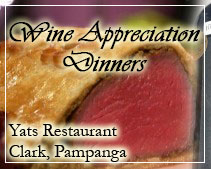The Land – 11July21
Ancient Pampanga’s territorial area used to include portions of the provinces of Bataan, Bulacan, Nueva Ecija, Pangasinan, Tarlac and Zambales in the big Island of Luzon of the Philippine Archipelago. The province derived its name from the Kapampangan words “Pangpang ilog” meaning “riverside” where the early Malayan settlements were concentrated along the Rio Grande de la Pampanga (Great Pampanga River) until such time the adventurous Malayan settlers expanded their domain into the hinterlands of the Kapampangan region.
Pampanga was the first province in the island of Luzon inaugurated by the Spaniards. It was founded on December 11, 1571 in the same year the City of Manila was established by Spanish Governor Miguel Lopez de Legaspi as the seat of national government. For governmental control and taxation purposes, the Spanish authorities subdivided the province into towns (pueblos), which were further subdivided into districts (barrios) and in some cases into royal and private estates.
In a report of Philippine encomiendas on June 20, 1591, Spanish Governor Gomez Perez Dasmarinas reported to the King of Spain that La Pampanga’s encomiendas were Batan, Bitis y Lubao, Macabebe, Candava, Apali, Calompit, Malolos, Binto, Guiguinto, Caluya, Bulacan and Mecabayan. The encomiendas of La Pampanga at that time had eighteen thousand six hundred and eighty whole tributes, or seventy-four thousand seven hundred and twenty souls.
Pampanga is now about 850 square miles (2,181 square kilometers) in land area and inhabited by about 1,636,000 people (per the 1995 Philippine National Census). As other Luzon provinces were created due to increases in population, some well-established Pampanga towns were lost to new emerging provinces in Central Luzon.
The historic province of Bataan, which was founded in 1754 under the administration of Spanish Governor General Pedro Manuel Arandia, absorbed from the province of Pampanga the municipalities of Abucay, Balanga, Dinalupihan, Llana Hermosa, Orani, Orion, Pilar, and Samal.
The old Pampanga towns of Aliaga, Cabiao, Gapan, San Antonio and San Isidro were ceded to the province of Nueva Ecija in 1848 during the term of Spanish Governor-General Narciso Claveria y Zaldua. Claveria was best remembered for issuing memorable decrees during his incumbency. One of Claveria’s history-making decrees was issued on August 16, 1844, which ordered that Tuesday, December 31, 1844 should be officially considered as Wednesday, January 1, 1845 thus eliminating December 31, 1844 from the Philippine calendar. There were neither births nor deaths officially registered in the Philippines on that date.
On November 11, 1849, Claveria issued a decree to systematize the selection and registration of names of the Filipino people. The decree called for Filipinos to have first names and surnames. It should be recalled that the early Filipinos usually have only one name like Lakandula, Soliman, Lapulapu, Humabon. The decree included a list of Spanish surnames, which were adopted by some Filipinos while others opted for Filipino last names instead. Today, many Filipinos have Spanish family names like Arnedo, Bonifacio, David, Escaler, Fausto, Gonzalez, Gutierrez, Hernandez, Ibarra, Inventor, Joven, Lopez, Lorenzo, Marquez, Mercado, Navarro, Pineda, Regala, Reyes, Rodriguez, Ronquillo, Ventura, Simon, Torres, Vargas, Vergara, Zuniga, etc.
The municipality of San Miguel de Mayumo of Pampanga was yielded to the province of Bulacan in the same provincial boundary configuration in 1848.
In 1860, the northern towns of Bamban, Capas, Concepcion, Victoria, Tarlac, Mabalacat, Magalang, Porac and Floridablanca were separated from Pampanga and were placed under the jurisdiction of a military command called Comandancia Militar de Tarlac. However, in 1873, the four latter towns were returned to Pampanga and the other five towns became municipalities of the newly created Province of Tarlac.
The Climate
Pampanga has two distinct climates, a rainy season and a dry season. The rainy or wet season normally starts in May and runs through October and the rest of the year is the dry season. The warmest period of the year is from March to April while the coldest period is from December through February of the following year.
Transportation
The province is accessible by air transportation via the Diosdado Macapagal International Airport (formerly called Clark International Airport) in the vicinity of Angeles-Porac-Mabalacat area. It is also easily accessible by land transportation. The railroad passes through the province. All bus lines linking Manila with Baguio, Pangasinan, and Ilocos pass through Pampanga. Philippine Rabbit, Pantranco North, and Victory Liner are some of the bus companies, which have frequent departures. The expressway meets MacArthur Highway at Dau, Mabalacat just north of Angeles City. Philippine Rabbit serves the provincial capital (San Fernando) from Manila. Victory Liner links Angeles City and Olongapo City. Baliwag Transit and E. Jose Transport operate cross-country services from Olongapo City to Cabanatuan City in Nueva Ecija via San Fernando, Pampanga. Arayat Express also serves the San Fernando-Cabanatuan route.
Industries
During the Spanish rule in the Philippines from the early 16th century to the late 19th century, Pampanga’s fertile plains, forestland and rivers were the most productive area in the Philippines. Manila and its surrounding region were then primarily dependent on Kapampangan agricultural, fishery, and forestry products as well as on the supply of tradesmen and other skilled workers.
The present primary sources of livelihood of the Kapampangan people are farming, fishing, manufacturing, handicrafts, poultry and swine and food processing industries. The fertile plains are suitable to sugar cane, rice, corn, vegetables and fruit trees. Rivers, streams and fishponds abound with milkfish (bangus), carps, catfish, shrimps, crabs and other marine products. Availability of well-trained human resources, good roads and other infrastructure, modern telecommunication systems, and abundant supply of raw materials and power attract many manufacturing and commercial firms to base their operations in this province. Many regional government offices and banking institutions are strategically located in Pampanga.
The Kapampangan People
Based on the findings of modern-day linguistic researchers and archeologists, the ancestors of original Kapampangans came from China via Taiwan. However, the old traditional belief that early Kapampangans have started migrating to the Kapampangan region as early as 300 to 400 A.D, and many of them arrived in the 11th to the 12th century is still carried on from generation to generation.
Based on oral traditions, Kapampangans were descendants of Malayan adventurers from the Malay Peninsula and Singarak Lake in West Sumatra. They settled along the river banks of the Rio Grande de la Pampanga in the Island of Luzon covering a large territory, which extended to the Gulf of Lingayen in the North, to the Zambales mountains in the West, to the Sierra Madre range in the East and to Manila Bay in the South. These Kapampangan-speaking pioneers transplanted their own dynasty based on the social foundations of liberty and economic prosperity. Like their other Malayan brothers who settled in other parts of the world, they belonged to the brown race, of medium height, slim but sturdy in physique, dark brownish eyes, black hair and with almost hairless bodies. They brought their culture and introduced industries such as smelting and manufacture of copper and iron tools and armaments, making of pottery with decorative designs, art of weaving cloth on a hand loom, manufacture of beads, bracelets, necklaces and other ornaments. They resided in houses made of bamboo and wood, with roofs of palm leaves. They wore clothes of woven fabrics and decorated themselves with jewels of gold, beads, pearls and colored stones and glasses. Their armaments included bolos, daggers, swords, bows and arrows, blowguns and spears. Their adaptability and resiliency made it possible for them to adjust themselves to Philippine environmental conditions and amplified their culture – arts, customs, government, law, religion, sciences, society and traditions.
Centuries before the arrival of the Spanish conquerors, Kapampangans were already in contact with the outside world by trading with Chinese, Japanese and Hindus. The good business relation with these Asian neighbors was not limited to commercial affair because the relationship extended to marital relations with native Kapampangans that is why many Kapampangans nowadays are of mixed Asian ancestry.
Many Chinese immigrants who moved out of Manila decided to settle in neighboring towns and married native women. Many Kapampangans today have family names like Ang, Chan, Cheng, Chingcuangco, Chu, Chua, Go, Goseco, Gosioco, Gueco, Ho, Lau, Lee, Mangio, Ng, Songco, Tan, Tang, Tanhueco, Tanjangco, Tanjuakio, Tanjuangco, Tiongco, Wang, Wong, Yang, Yap, Uy, etc.
The interracial crossing of Chinese and Kapampangans and other ethnic Filipinos produced a mixed breed of descendants capable of accelerating a nation’s growth in terms of economy, politics, culture, etc., resulting from the blending of the courage and resiliency of the Malay stock and the frugality and sagacity of the yellow race.
China’s influences were primarily economic and social. Kapampangans and other Filipinos in general, learned the Chinese way of roasting pigs, the brewing of tea for drinking and the cooking of such dishes as lumpia, pansit, mami, tsapsoy and ukoy. The use of appetizers like tauri and toyo originated from China and so with the cultivation of certain vegetables such as petsay, upo, bataw, etc.
In 1571, the Spanish conquistadores heard of the Kapampangan progressive civilization when their conquest of the Maynilad (Manila) and Tondo kingdoms was accomplished. The Spaniards came upon the Kapampangan people with a rich culture, literature and an alphabet of their own. The Kapampangans were described then to be the most warlike and prominent ethnic group in the Philippines. To defend themselves from Spanish invasion, they fortified the mouths of the rivers leading to their territories.
Spanish colonialism had for its principal purpose of converting the natives whom they called indios to Christianity. The Christian cross was so powerful in converting the riverside Muslim communities. Kapampangan members of the Roman Catholic Church normally attend official church services such as masses, novenas, baptisms, confirmations, weddings, religious processions and funeral services.
One unifying force that calls for community solidarity is the annual town or barangay fiesta, which is celebrated in honor of a patron saint. Festivities and abundance of food characterize fiestas. A fiesta generally includes a mass, a colorful parade, a lively amateur singing contest, an entertaining stage show, a dinner- dance, crowning of beauty queens and princesses, sports tournaments, cockfights, carnivals, etc. Kapampangans, who are well known for their hospitality and skill in the art of cooking and baking, open their homes during fiestas and entertain their guests.
Christmas celebration starts nine days before Christmas. Kapampangan Roman Catholic members attend nine early morning masses (misa de gallo). Lanterns are hanged in homes and Christmas carols are sung. On Christmas eve, a midnight mass is celebrated and after the church service, the families have traditional dinners called “noche buena”. The family dinner is followed by the exchange, distribution and opening of Christmas gifts.
In the city of San Fernando, an annual giant lantern contest is held every 24th of December. Multi-colored lanterns as big as 30 feet in diameter and with thousands of electric bulbs are mounted on big trucks and paraded in town main streets accompanied by marching bands. The Philippine Board of Tourism, which sponsors the yearly giant lantern contest, displays the winning entries at the Paskuhan Village, Luneta Park in Manila and sometimes in other foreign countries during the Yuletide season. Christmas day is spent for reunions and visiting. Children pay their respect to their relatives and godparents. Kissing the hands of parents, elder relatives and godparents symbolizes traditional respect, loving and caring.
The Lent season is observed by reading or chanting the Passion of Jesus Christ. A re-enactment of the crucifixion of Jesus Christ is held on Good Friday in barrio San Pedro Cutud of San Fernando. In most Catholic parishes, religious processions along the streets bordering the parish churches are held. Members of religious organizations such as the Knights of Columbus, Legion of Mary and Cursillos in Christianity participate in religious processions. Masses are celebrated on Easter Sundays and other religious activities take place such as the burning of the image of Judas and the meeting (salubong) of Jesus Christ and the Virgin Mary.
The Spanish and American colonizers made also a tremendous impact on the economic, political and family lives of many Kapampangans. It is not uncommon to see many Spanish-American-Kapampangan mestizos in several towns of Pampanga resulting from inter-racial marriages.
The Kapampangan Language
Together with their rich culture and excellent traditions, the early settlers in Pampanga perpetuated their unique language now called either as Pampangan or Kapampangan or Pampango. This language is one of the Austronesian languages and according to the Dictionary of Languages by Andrew Dalby, as of 1998, there are 1,850,000 Kapampangan speakers. Kapampangan was once written in a native script, a descendant of the Brahmi script of India. This remained in use until the late 19th century when the Spanish era was about to end. However, printing in Kapampangan – in Latin script – commenced as early as the year 1618. Spelling was at first close to that of Spanish. A new orthography, similar to Tagalog orthography was introduced in 1965. Many old and traditional writers and poets in Kapampangan have switched since then to this newly adopted orthography.
Relation with foreigners visiting the region or Kapampangans going overseas either for pleasure, for business, for education or for employment, make it difficult to preserve the purity of the old Kapampangan language and culture.
Commercial contact and inter-marriages with Chinese resulted to the assimilation of Chinese words to the Kapampangan vocabulary. Among these Kapampangan words with Chinese origin are the following:
Chinese English
ampaw
atse, atsi
bakya
biko
batsoy
biun
bilog-bilog
betsin
bukas
bukut
bulong puffed rice or corn
elder sister
wooden shoes
sweetened whole-rice cake
chopped entrails of pig sauted with kutsay
wire-like noodles made from rice flour
balls or rounds of rice dough
powder for flavoring food
tomorrow
bent or curved back
whisper
More Kapampangan words with Chinese origin
Pampanga was a focal point of interest for politicians, businessmen and the landed (wealthy) society during the Spanish era. As such, the province was placed at the forefront of the “Hispanization” of the Philippines. The Kapampangan people just like other Philippine ethnic groups were greatly influenced by the culture and language of Spain. Many Spanish words such as the following found their way into the list of spoken and written words of the Kapampangan people in their day to day living.
Spanish English
abanico
abogacia
abogado
abono
abrazo fan
law, the legal profession
lawyer, attorney
fertilizer, manure
embrace, hug
More Kapampangan words with Spanish origin
There are hundreds of Spanish words that have been incorporated into the Kapampangan vocabulary and to other Philippine languages resulting from the possession of the Philippines as a colony of Spain for more than three centuries. An expanded listing of Kapampangan words with Spanish origin is included in “Spanish Relation with Kapampangan Language and Culture” written by the same authors of this article.
With English as the primary language of instruction in Philippine schools since the American occupation of the Philippines in the late 19th century until July 4, 1946, many English words were also integrated in the vocabularies of main Philippine languages without exception to the native language of the Kapampangan people.
Source: http://www.andropampanga.com/history.htm
Wedding couples like the idea of a getaway to travel out of town from Manila to the north and book beautiful outdoor venues in highly recommended top rated hotels and resorts. One of the most popular wedding spot in the north is Clearwater Resort and Country Club. This hotel in Clark offers over ten outdoor garden venues for wedding receptions as small as 50 guests to over 500 persons. These are private venues and all event venues offer a special kind of romantic ambience to help make the wedding reception a memorable one.
Pampanga is an important province of the Philippines slated to be the next business and tourism center of the country. Already international traffic prefers the Clark International Airport and tourists find Clark Freeport Zone easier to get around than Manila. Safety, low crime rate, no traffic and low pollution levels all contribute to making Pampanga Angeles City Clark Freeport Zone a preferred destination for local and international tourists.
For reservations, comments and inquiries,
www.philippinesweddingvenue.com
Philippines Wedding Venues Service Center
Creekside Road corner of Centennial Road,
Central Business District, Clark Freeport Zone,
Pampanga, Philippines 2023
Tel: (045)599-5949 0917-520-4403 0922-870-5177
Manila Sales Office
3003C East Tower, Phil Stock Exchange Center,
Exchange Rd Ortigas Metro Manila, Philippines 1605
(632) 637-5019 0917-520-4393 Rea or Chay
Email: Wedding@Yats-International.com
For any assistance in planning and organizing a wedding ceremony, indoor or outdoor garden reception or to find other wedding service providers, Click here to contact us click here
For assistance in hotel and resort bookings in Clark, Pampanga, Philippines, log on to
http://www.HotelClarkPhilippines.com
To inquire with the highly recommended beach resort hotel in Clark Pampanga visit http://www.ClearwaterPhililippines.com
For more information about Clark, Pampanga, Philippines log on to
http://www.ClarkPhilippines.com









